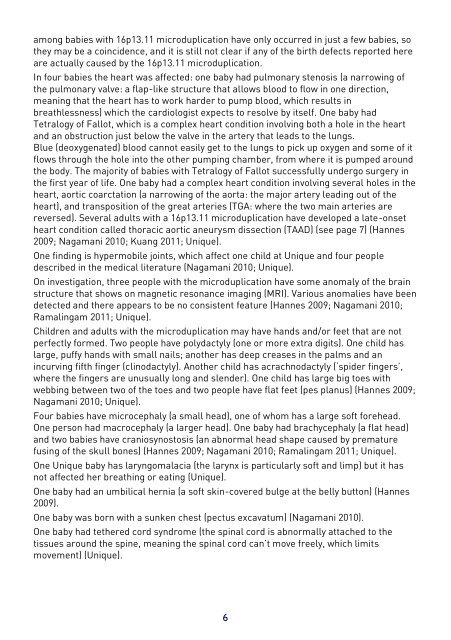16p13.11 microduplications - Unique - The Rare Chromosome ...
16p13.11 microduplications - Unique - The Rare Chromosome ...
16p13.11 microduplications - Unique - The Rare Chromosome ...
You also want an ePaper? Increase the reach of your titles
YUMPU automatically turns print PDFs into web optimized ePapers that Google loves.
among babies with <strong>16p13.11</strong> microduplication have only occurred in just a few babies, so<br />
they may be a coincidence, and it is still not clear if any of the birth defects reported here<br />
are actually caused by the <strong>16p13.11</strong> microduplication.<br />
In four babies the heart was affected: one baby had pulmonary stenosis (a narrowing of<br />
the pulmonary valve: a flap-like structure that allows blood to flow in one direction,<br />
meaning that the heart has to work harder to pump blood, which results in<br />
breathlessness) which the cardiologist expects to resolve by itself. One baby had<br />
Tetralogy of Fallot, which is a complex heart condition involving both a hole in the heart<br />
and an obstruction just below the valve in the artery that leads to the lungs.<br />
Blue (deoxygenated) blood cannot easily get to the lungs to pick up oxygen and some of it<br />
flows through the hole into the other pumping chamber, from where it is pumped around<br />
the body. <strong>The</strong> majority of babies with Tetralogy of Fallot successfully undergo surgery in<br />
the first year of life. One baby had a complex heart condition involving several holes in the<br />
heart, aortic coarctation (a narrowing of the aorta: the major artery leading out of the<br />
heart), and transposition of the great arteries (TGA: where the two main arteries are<br />
reversed). Several adults with a <strong>16p13.11</strong> microduplication have developed a late-onset<br />
heart condition called thoracic aortic aneurysm dissection (TAAD) (see page 7) (Hannes<br />
2009; Nagamani 2010; Kuang 2011; <strong>Unique</strong>).<br />
One finding is hypermobile joints, which affect one child at <strong>Unique</strong> and four people<br />
described in the medical literature (Nagamani 2010; <strong>Unique</strong>).<br />
On investigation, three people with the microduplication have some anomaly of the brain<br />
structure that shows on magnetic resonance imaging (MRI). Various anomalies have been<br />
detected and there appears to be no consistent feature (Hannes 2009; Nagamani 2010;<br />
Ramalingam 2011; <strong>Unique</strong>).<br />
Children and adults with the microduplication may have hands and/or feet that are not<br />
perfectly formed. Two people have polydactyly (one or more extra digits). One child has<br />
large, puffy hands with small nails; another has deep creases in the palms and an<br />
incurving fifth finger (clinodactyly). Another child has acrachnodactyly (‘spider fingers’,<br />
where the fingers are unusually long and slender). One child has large big toes with<br />
webbing between two of the toes and two people have flat feet (pes planus) (Hannes 2009;<br />
Nagamani 2010; <strong>Unique</strong>).<br />
Four babies have microcephaly (a small head), one of whom has a large soft forehead.<br />
One person had macrocephaly (a larger head). One baby had brachycephaly (a flat head)<br />
and two babies have craniosynostosis (an abnormal head shape caused by premature<br />
fusing of the skull bones) (Hannes 2009; Nagamani 2010; Ramalingam 2011; <strong>Unique</strong>).<br />
One <strong>Unique</strong> baby has laryngomalacia (the larynx is particularly soft and limp) but it has<br />
not affected her breathing or eating (<strong>Unique</strong>).<br />
One baby had an umbilical hernia (a soft skin-covered bulge at the belly button) (Hannes<br />
2009).<br />
One baby was born with a sunken chest (pectus excavatum) (Nagamani 2010).<br />
One baby had tethered cord syndrome (the spinal cord is abnormally attached to the<br />
tissues around the spine, meaning the spinal cord can’t move freely, which limits<br />
movement) (<strong>Unique</strong>).<br />
6

















